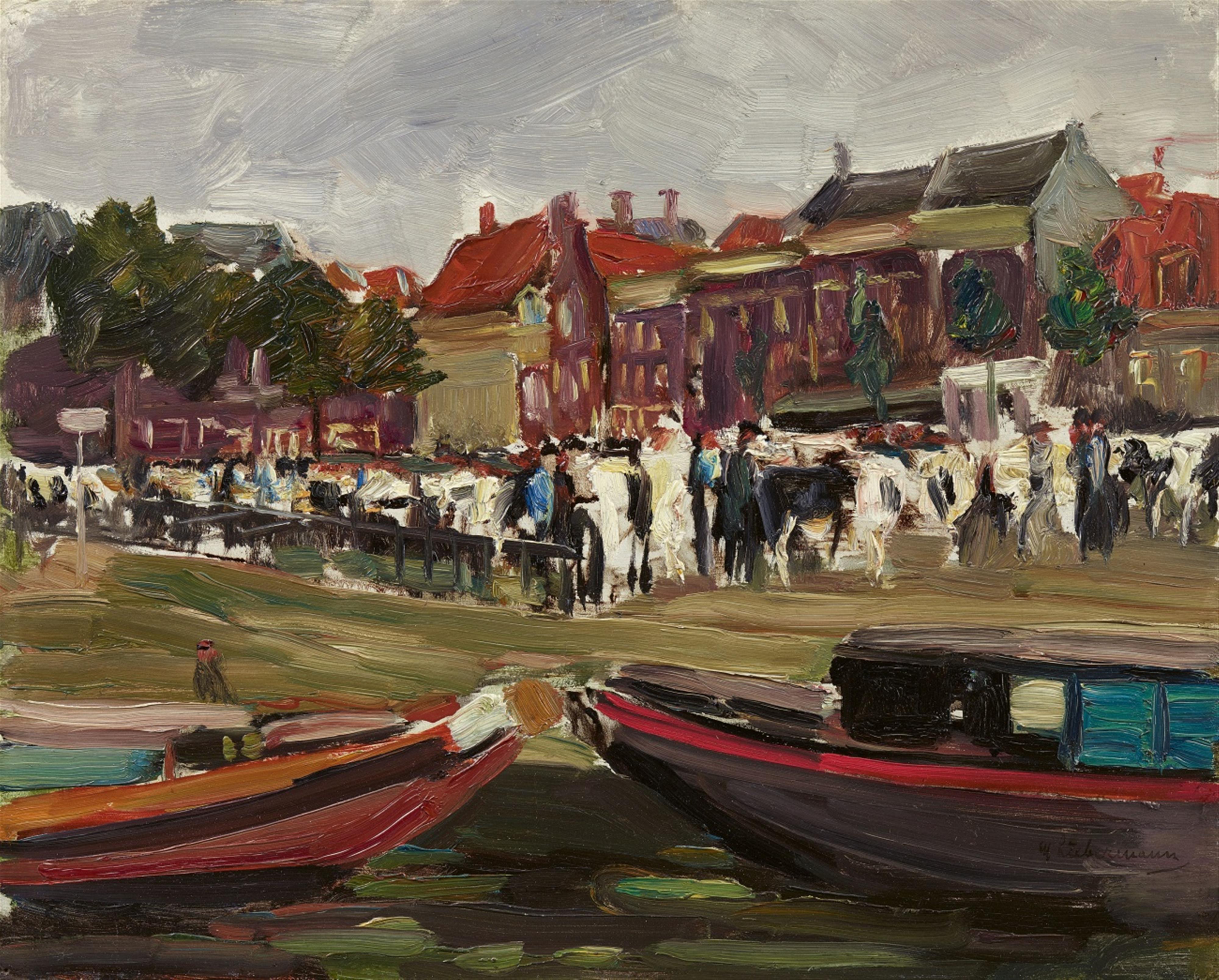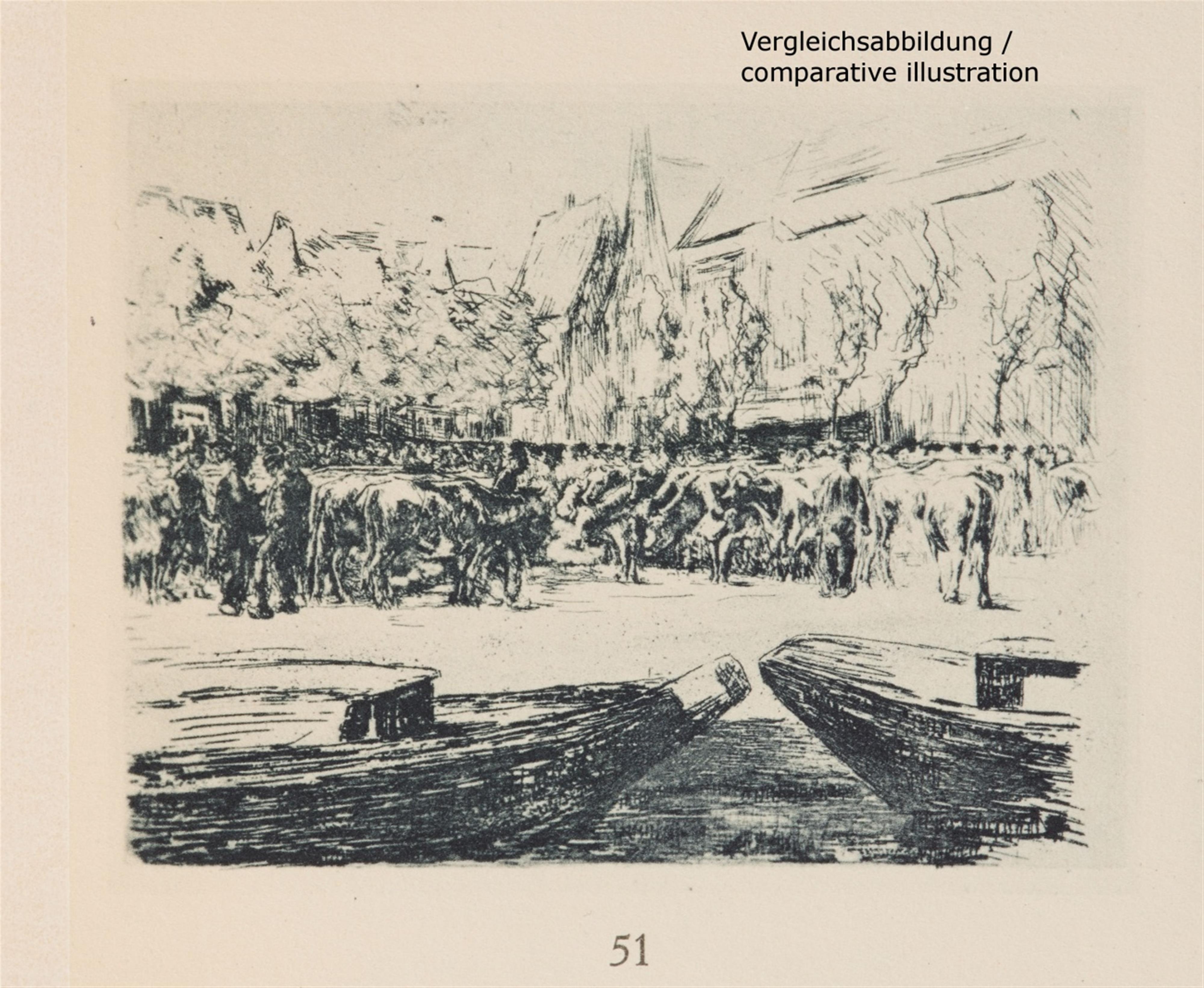Max Liebermann
Studie zum "Rindermarkt in Leiden"
1900
Oil on firm artist's board 32.6 x 40.2 cm Framed. Signed 'M Liebermann' laterally in black India ink in the depiction lower right. - Stamp of a Dutch paint company from The Hague verso on card. - In fine condition with minor marginal defects. The corners of the board with traces of drawing pins.
In their early monographs on Max Liebermann Gustav Pauli and Erich Hancke both mention an oil study for the larger canvas painting “Rindermarkt in Leiden” (60 x 71 cm, Eberle 1901/26). It was formerly owned by Alfred Hagelstange (1874-1914), the former director of the Wallraf-Richartz-Museum in Cologne. Itemized as being painted on “wooden panel” (a detail that Matthias Eberle adopted in his catalog raisoné of Max Liebermann's paintings), in his current expert opinion on the present work he corrects this: The study is painted on card. In fact, Eberle also discerned in the background in each instance on two different photo portraits of the artist in his studio a long blackboard to which oil studies on card are pinned, including one on the “Rindermarkt” (see documentation with the Eberle report). Liebermann also produced a well-known etching based on the same theme (Schiefler 51, see also comparative illus.).
In the study, Liebermann evidently created a first outline for the theme which defined the cropping of the image, the spatial setting, and the basics of the composition. These elements were then incorporated into the larger format of the piece on canvas and into the etching in terms of the identical scenery on the banks of the canal with the two barges in the foreground. The central section with the animal market and the people was structured later, more precisely in the drawing, and painted in great detail. In the oil study, setting a rhythm Liebermann uses large abstract brushstrokes to record the mass of the cattle while the group of figures is painted in an indefinite, leisurely manner, capturing the vibrant colour impression and without distinguishing the individual forms. This gives rise to a dynamism emphasized by the colour and painterly accents, something which in general typified Liebermann's studies on card compared to the final versions on canvas.
Catalogue Raisonné
Eberle 1900/15 (there still mentioned as "verschollen")
Certificate
With an expert report by Matthias Eberle, Berlin, dated 1 September 2002
Provenance
Max Liebermann, Berlin (1902); Direktor Alfred Hagelstange, Cologne (1911); Paul Cassirer, Berlin (1917); Galerie Caspari, Munich (1917); Private collection, Rhineland; Private collection, South Germany
Literature
Gustav Pauli, Max Liebermann. Des Meisters Gemälde, (Klassiker der Kunst, Neunzehnter Band), Stuttgart/Leipzig 1911, p. 246, annot. p. 129 (Mention of the "oil study" in the "possession of Mr. Director Dr. Hagelstange in Cologne"); Erich Hanke, Max Liebermann. Sein Leben und seine Werke, Berlin 1914, p. 402, catalogue raisonné p. 539 ("Rindermarkt in Leiden (Studie)", with indication of provenance "Director Hagelstange, Cologne a. Rh.")
Exhibitions
Apolda 2011 (Kunsthaus Apolda Avantgarde) und Aschaffenburg 2012 (Kunsthalle Jesuitenkriche), Reiselust und Sinnesfreude, Corinth - Liebermann - Slevogt, cat. no. 27 with colour illus. p. 93 ("Rindermarkt in Leyden")




